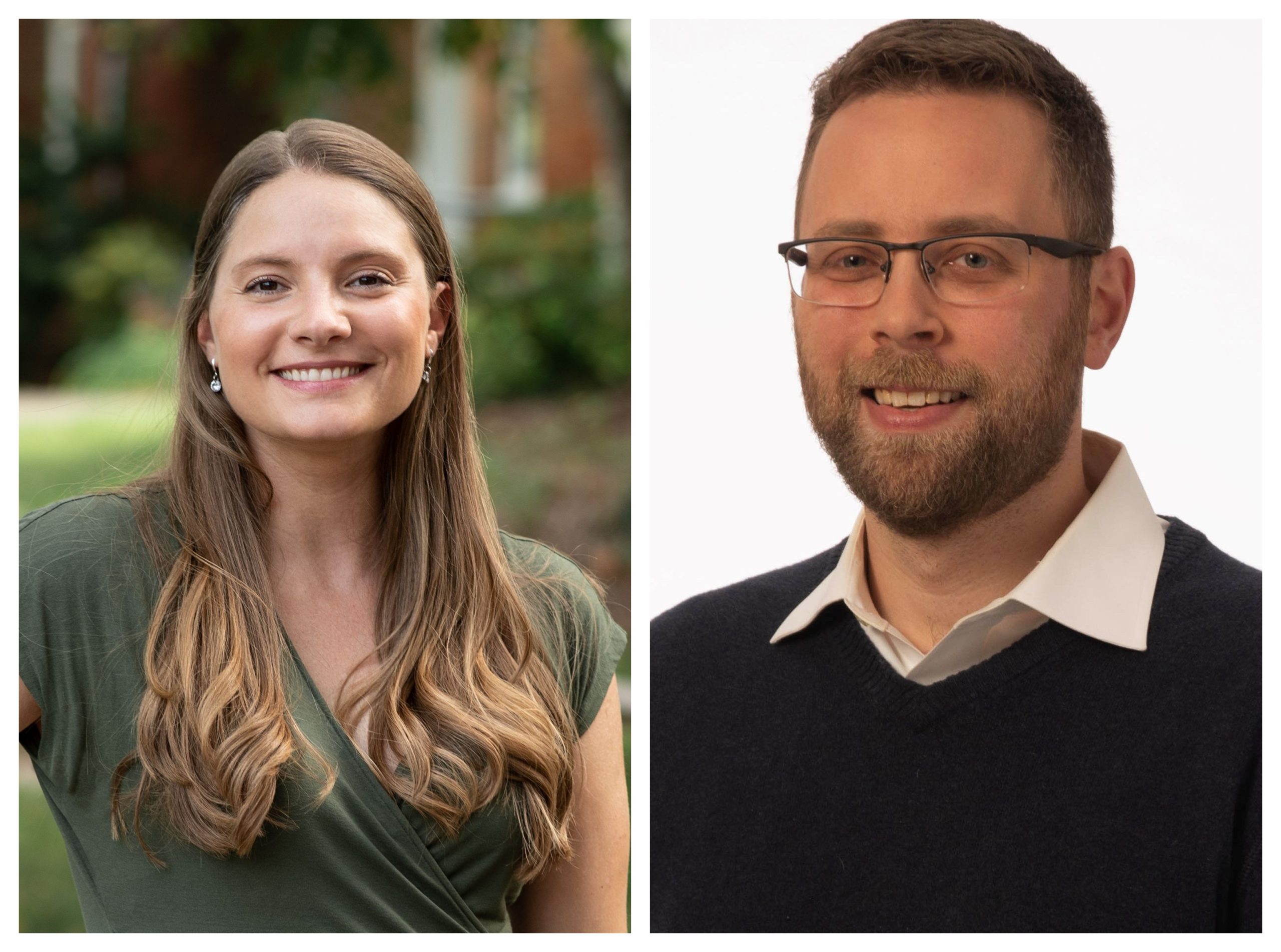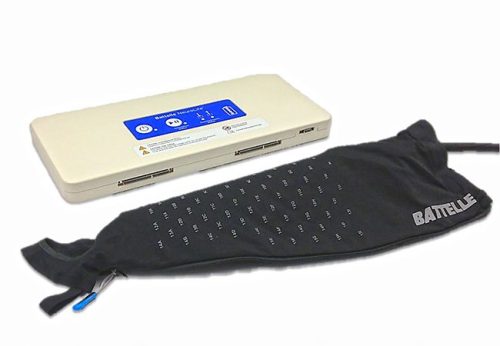In conversation with Praxis SCI Incubate Cohort Member, Battelle

Non-invasive wearable medtech aids rehab potential
Interview with Chelsea Fuller, Senior Product Manager and David Friedenberg , Principal in Neurotechnology and Data Science at Battelle.
Battelle is the world’s largest not for profit, contract research and development organization. Dave and Chelsea work in a division of the organization that’s focused on medical device development.
Battelle’s NeuroLife® wearable sleeve showcases a unique background in developing life-enhancing products. For the first time ever, this technology allows us to measure the nerves and muscles of the forearm with high resolution and in real-time. The result is targeted stimulation interventions that recreate complex, dexterous hand movements.
Visit their website

What makes Battelle interested in med tech development for spinal cord injury?
David: Battelle got interested in neuro tech about 10 years ago and saw the potential for brain computer interfaces for paralysis. There were some improvements we saw we could make, and maybe combine into a complete system.
Personally, I started working with a participant in a clinical study, and very quickly found it eye opening just to see what his daily life was like, and to see what this technology, even in its very experimental form, was able to do for him. I could see all sorts of potentials.
What’s been the biggest learning or takeaway from the program for you and Battelle?
Chelsea: The clinical teams were able to help with some of the research and strategies from a commercial lens. I really valued the networking and perspectives on what we lacked, on things like regulatory and reimbursement on pitching. The focus group was exceptionally helpful.
I was excited to get to know the clinical and business professionals and have connected with them on LinkedIn now. The internal personal networks and relationships that we were able to build amongst the professionals driving towards the same end goal for this clinical population and individuals with lived experiences was more than I expected.
David: One of the biggest things is maybe different from a lot of the other companies, which might be small companies or startups. The whole program was very eye opening on how to get our tech out there. I spent more time with our commercialization folks than I ever had, walking through what they were using in their pitch decks and making sure that all the best info went into them. So not just thinking from a purely science perspective but thinking about it through reimbursement lens and through the regulatory lens, through the pitching lens and the fundraising lens. For startups, all those people are the same person.
What changes have you made to the product itself or your process from what you’ve learned in the program?
Chelsea: We’re looking at other funding mechanisms for the future.
David: We’ve changed the way we’re pitching to potential investors and thinking about some of the reimbursement and regulatory issues.
How has your view on the challenges faced by your potential users changed?
Chelsea: The focus groups, especially the Praxis program team that we were working with each week helped us think about daily life and consider the usability of the device. We also gained a lot of understanding around initiation of the device, and initial hesitancies that people might have. Considerations for usability are really important.
Having a broad range of feedback from different kinds of users gave a more realistic narrative, internally to the business and externally in terms of who we would want to target first. This included clinicians and therapists that might want to recommend this technology in the future. We need to understand that the device may not be for everybody. What helps is understanding that if there’s a way to adapt our device so that it can meet more people’s needs, with the singular form factor or a certain set of software and library activities or functional capabilities, then it’s good to know that we can design it. Then we’re more likely to get people thinking about using it because we’ve proactively addressed the variability of the patient’s functionality.
David: I tend to be in a lot of the research sessions so I do have experience with individuals with spinal cord injury using our system and providing feedback when they’re using our tech. But I think the focus groups gave us more like a blue sky. The people that are enrolling in our clinical trials are probably not a fully representative sample; they’re individuals who have the transportation, the time and financial ability to participate in these trials. And that’s not necessarily representative of the entire population. I think the focus groups were really helpful there.

What’s unique about the Battelle product; what differentiates it from the competition?
Chelsea: The unique thing about this device is its ability to be leveraged across the continuum of care. It has the ability to be used in a clinical setting, facilitating rehabilitation activities, and then continued outside of the clinical setting. People can use it in the community or at home, continuing to provide not only functional benefit to the user, but also ongoing rehabilitation outside of the clinical setting.
The word that we like to use for this technology is that it reinforces, meaning that whatever you’re trying to achieve, doing it on a day-in, day-out basis beyond the clinical setting, means you’re practicing. And it’s more than you think you are by just living your life and allowing the technology to functionally help you do the things that you want to do.
David: Our device can detect the intent to move and stimulate to help complete that move with a non-invasive wearable. This is a system that someone relatively early in their injury pathway could potentially come into a clinic, put the sleeve on, work with it with the clinician for an hour, take it off and go home. This could turn into a rehab protocol used at home. The simplicity of the system is it’s noninvasive, and relatively easy to take on and off, but still has the power to detect. Even if you can’t open your hand, it can sense your intent and that can help you open your hand.
What did you hope to get out of the SCI incubate program?
David: We hoped to expand our network and open doors to talk to people that we knew we needed to talk to, but maybe didn’t have the connections to get in front of. We got this, and instances where we were able to get in front of people that we didn’t even realize that we needed to get in front of when we started.
What would you say to a company that was thinking of joining the SCI Incubate program?
Chelsea: While the time is intensive to be able to keep up with the pace that Praxis will put you through, you will get out tenfold what you put into it. If you can keep up and you’re very focused and driven towards helping this community with your technology, the time that you spend to leverage the resources, have the conversations, listen, and implement the feedback that you’re getting, will benefit your success in development and launch of the technology.
Also, if someone comes to the table without a concept of even how to get started, the mentors and experts were able to provide examples of what other companies have done to help jumpstart the thought process. So, the fact that Praxis has collected examples from many companies at many different stages and levels of commercialization, technology development or technology readiness for the market really helps individuals coming into this with perhaps less breadth of experience in some of these areas.
David: We had the opportunity to ask experts, and then they turned around with their whole network behind them. A lot of times they were able to answer our questions off the top of their head, but also, they’d say, let me make a couple calls. And then within a week later, we’re on the call with a world expert. I found that was really, really, helpful.
Learn more about the 2022-2023 Praxis SCI Incubate Alumni!
Disclaimer: The technology shown or featured is investigational, not commercially available, and has not been approved or cleared for treatment, cure or mitigation of any disease by the FDA. Results shown are from studies performed.
We definitely had some people the first time that we stimulated them, and they were able to move their hand again; a lot of them especially hadn’t been able to move for years, and just being able to see their hand move is very powerful for them.
Very quickly they’re asking, Okay, can I take it home? Can I do this? Can I do that? The first time they see their hands moving, it was always pretty powerful.
This isn’t just a kind of a gimmick that is like, Oh, hey, my hand moves. This is actually something that I can use in my daily life. This is something that can improve my daily life, it can reduce my reliance on the caregiver, it increases my independence, it allows me to do things that I’ve wanted to do that haven’t been able to do because of injury. Those are the reactions that kind of stick out.
Feedback from user groups
